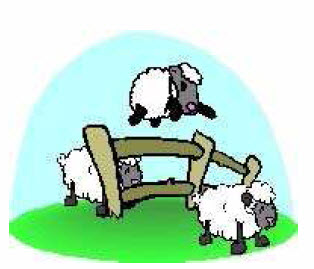Counting Sheep
Time Limit : 2000/1000ms (Java/Other) Memory Limit : 32768/32768K (Java/Other)
Total Submission(s) : 35 Accepted Submission(s) : 24
Font: Times New Roman | Verdana | Georgia
Font Size: ← →
Problem Description
A while ago I had trouble sleeping. I used to lie awake, staring at the ceiling, for hours and hours. Then one day my grandmother suggested I tried counting sheep after I'd gone to bed. As always when my grandmother suggests things, I decided to try it out. The only problem was, there were no sheep around to be counted when I went to bed.

Creative as I am, that wasn't going to stop me. I sat down and wrote a computer program that made a grid of characters, where # represents a sheep, while . is grass (or whatever you like, just not sheep). To make the counting a little more interesting, I also decided I wanted to count flocks of sheep instead of single sheep. Two sheep are in the same flock if they share a common side (up, down, right or left). Also, if sheep A is in the same flock as sheep B, and sheep B is in the same flock as sheep C, then sheeps A and C are in the same flock.
Now, I've got a new problem. Though counting these sheep actually helps me fall asleep, I find that it is extremely boring. To solve this, I've decided I need another computer program that does the counting for me. Then I'll be able to just start both these programs before I go to bed, and I'll sleep tight until the morning without any disturbances. I need you to write this program for me.

Creative as I am, that wasn't going to stop me. I sat down and wrote a computer program that made a grid of characters, where # represents a sheep, while . is grass (or whatever you like, just not sheep). To make the counting a little more interesting, I also decided I wanted to count flocks of sheep instead of single sheep. Two sheep are in the same flock if they share a common side (up, down, right or left). Also, if sheep A is in the same flock as sheep B, and sheep B is in the same flock as sheep C, then sheeps A and C are in the same flock.
Now, I've got a new problem. Though counting these sheep actually helps me fall asleep, I find that it is extremely boring. To solve this, I've decided I need another computer program that does the counting for me. Then I'll be able to just start both these programs before I go to bed, and I'll sleep tight until the morning without any disturbances. I need you to write this program for me.
Input
The first line of input contains a single number T, the number of test cases to follow.
Each test case begins with a line containing two numbers, H and W, the height and width of the sheep grid. Then follows H lines, each containing W characters (either # or .), describing that part of the grid.
Each test case begins with a line containing two numbers, H and W, the height and width of the sheep grid. Then follows H lines, each containing W characters (either # or .), describing that part of the grid.
Output
For each test case, output a line containing a single number, the amount of sheep flock son that grid according to the rules stated in the problem description.
Notes and Constraints
0 < T <= 100
0 < H,W <= 100
Notes and Constraints
0 < T <= 100
0 < H,W <= 100
Sample Input
2 4 4 #.#. .#.# #.## .#.# 3 5 ###.# ..#.. #.###
Sample Output
6 3
#include <iostream> #include<cstdio> #include<cstring> #include<deque> using namespace std; struct node { int x,y; }; int dr[8][2]={{1,0},{0,1},{-1,0},{0,-1}}; deque<node> s; int i,j,n,m,num,t; char ch[102][102]; void bfs(int x,int y) { node t; t.x=x; t.y=y; ch[x][y]='*'; s.push_back(t); while(!s.empty()) { node p=s.front(); for(int i=0;i<4;i++) { int xx=p.x+dr[i][0]; int yy=p.y+dr[i][1]; if (xx>=0 && xx<n && yy>=0 && yy<m && ch[xx][yy]=='#') { t.x=xx; t.y=yy; ch[xx][yy]='.'; s.push_back(t); } } s.pop_front(); } return; } int main() { scanf("%d",&t); for(;t>0;t--) { scanf("%d%d",&n,&m); num=0; for(i=0;i<n;i++) scanf("%s",&ch[i]); for(i=0;i<n;i++) for(j=0;j<m;j++) if (ch[i][j]=='#') { bfs(i,j); num++; } printf("%d\n",num); } return 0; }